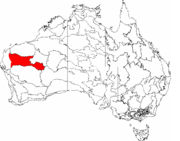
Western Australian Mulga shrublands
Encyclopedia


Ecoregion
An ecoregion , sometimes called a bioregion, is an ecologically and geographically defined area that is smaller than an ecozone and larger than an ecosystem. Ecoregions cover relatively large areas of land or water, and contain characteristic, geographically distinct assemblages of natural...
of inland Western Australia
Western Australia
Western Australia is a state of Australia, occupying the entire western third of the Australian continent. It is bounded by the Indian Ocean to the north and west, the Great Australian Bight and Indian Ocean to the south, the Northern Territory to the north-east and South Australia to the south-east...
.
Location and description
This is a hot, dry area with little rainfall.The region consists of the Gascoyne
Gascoyne (biogeographic region)
Gascoyne is an Interim Biogeographic Regionalisation for Australia region in Western Australia and part of the Western Australian Mulga shrublands ecoregion .-Further reading:...
, and Murchison
Murchison (biogeographic region)
Murchison is an Interim Biogeographic Regionalisation for Australia region in Western Australia and part of the Western Australian Mulga shrublands ecoregion .-Further reading:...
bioregions of the Interim Biogeographic Regionalisation for Australia
Interim Biogeographic Regionalisation for Australia
The Interim Biogeographic Regionalisation for Australia is a biogeographic regionalisation of Australia developed by the Australian Government's Department of the Environment, Water, Heritage and the Arts...
(IBRA).
Flora and fauna
The predominant vegetation is mulgaMulga
Acacia aneura, commonly known as Mulga or True Mulga, is a shrub or small tree native to arid outback Australia of areas such as the Western Australian Mulga shrublands.-Description:...
trees, a type of acacia
Acacia
Acacia is a genus of shrubs and trees belonging to the subfamily Mimosoideae of the family Fabaceae, first described in Africa by the Swedish botanist Carl Linnaeus in 1773. Many non-Australian species tend to be thorny, whereas the majority of Australian acacias are not...
adapted to the hot, dry climate by means of long tap roots. In some areas the mulga trees are surrounded by Eriachne
Eriachne
Eriachne is a genus of grass in the Poaceae family found in areas such as the Western Australian Mulga shrublands ecoregion. .-External links:*...
grassland.
Wildlife of the region includes birds such as emu
Emu
The Emu Dromaius novaehollandiae) is the largest bird native to Australia and the only extant member of the genus Dromaius. It is the second-largest extant bird in the world by height, after its ratite relative, the ostrich. There are three subspecies of Emus in Australia...
s, Australian Bustard
Australian Bustard
The Australian Bustard, Ardeotis australis, is a large ground bird of grassland, woodland and open agricultural country across northern Australia and southern New Guinea. It is also commonly referred to in Central Australia as the Bush Turkey, particularly by Aboriginal people.The male is up to ...
s and honeyeater
Honeyeater
The honeyeaters are a large and diverse family of small to medium sized birds most common in Australia and New Guinea, but also found in New Zealand, the Pacific islands as far east as Samoa and Tonga, and the islands to the north and west of New Guinea known as Wallacea...
s.
Most of the area is uninhabited but there is some mining activity and some sheep grazing, both of which cause damage to native habitats.

